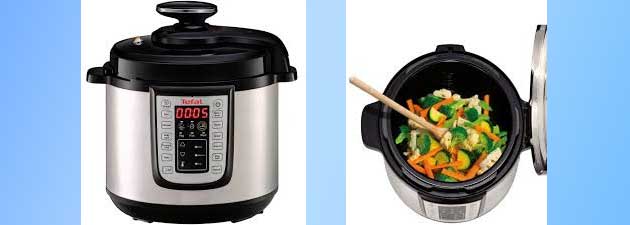Какъв мултикукър да си купя и как да избера. Мнения за най-добрия мултикукър. Класация: Филипс, Нинджа Foodi, Тефал, Делимано, Косори, Esperanza, Crown и другите
Мултикукърите са потомци на оризоварките, които първи се появяват през 1945 г. Съвременните модели са многофункциони. Те готвят с минимално участие на човека.
На какво да се опрем при избора, показва нашата таблица.
| Правила за избор на мултикукър | |
|---|---|
| Параметър | Добри показатели |
| Функционалност | елементарните модели поддържат няколко режима, а има и скъпи с допълнителни функции като отложен старт, поддържане на топлина, изпускане на пара от специален клапан |
| Типове програми | елементарните модели поддържат основните режими, а други имат над 25 настройки за хляб, еър фрайър, квасене, пара, налягане и др. |
| Вградени рецепти | предвидено само в луксозните модели – успешните рецепти се запаметяват за автоматично възпроизвеждане в бъдеще |
| Мощност | от нея зависи бързината на готвене. Маломощните модели са 400 – 500 W, средните – до 900 W, най-обемните са от 1 кW и нагоре |
Мнения кой е най-добрият мултикукър
Сред харесваните и препоръчвани модели са Gorenje MCB6BA, Делимано, Силвър Крест, някои от моделите на Филипс, Редмонд, Olla, Ариели.
Оставаме с впечатление, че мултикукърите по принцип носят удовлетворение, затова потребителите хвалят модела, който притежават.
Contents
- Мнения кой е най-добрият мултикукър
- Мултикукър Tefal CY505E30 One Pot
- Tefal Cook4Me CY851130
- Мултикукър Tefal 16 в 1 SpheriCook RK745800
- Мултикукър Philips HD2237/40 all in one
- Мултикукър Косори под налягане
- Мултикукър Делимано 18 в 1
- Нинджа Мултикукър Ninja Foodi MAX OP500EU
- Мултикукър Esperanza EKG011
- Мултикукър Crown CPC-60SS, 6 л
- Мултикукър Мюлер
- Как да изберем мултикукър?
Единствено за някои Филипси се четат негативни отзиви. Критиката е насочена към покритието на съда. Оплакванията са от бързо надиране или отслойване от основата в резултат на което ястията започват да залепват и загарят.
ВАЖНО: Вижте още мнения за това, кой е най-добрият мултикукър, напишете и своя отзив или направо попитайте ТУК, в нашия форум с коментари!
Мултикукър Tefal CY505E30 One Pot
Уред от серията One Pot или готвене на всичко под един капак.

- Технически параметри: мощност 1200 W, вместимост 5.8 л, 25 програми, включително работа под налягане.
- Екстри: задържане на топлина, бързо готвене, автоматизирана работа, таймер, температурен контрол, отложен старт, система за подсигуряване при високо налягане;
- Програми: всички основни технологии на готвене + варене на сладка и конфитюри, приготвяне на бебешка храна, претопляне, замесване на тесто, печене на хляб
- Комплект: Купа, шпатула, кошница за готвене на пара, книга с рецепти, мерителен съд за дозиране.
- Критики от потребители: загрява бавно (около 20 минути), необходимо е да се държи бутона за изпускане на пара, докато приключи, открехване на капака при високо налягане, зле написано упътване, ограничен брой рецепти, некоректно посочени времена за готвене.
Tefal Cook4Me CY851130
Умен мултикукър с интуитивен контрол. Автоматично адаптира количеството на съставките към брой порции.

- Технически параметри: мощност 1600 W, обем 6 л (до 6 порции), 6 технологии на готвене със 150 конкретни програми / рецепти + инструкции по стъпки.
- Програми: на пара, под налягане, класическо на 3 температури, бавно, печене, варене и поддържане на топлина.
- Екстри: съвместими части със съдомиялна, таймер, отложен старт, подсигуряване при високо налягане.
- Критики от потребители: необходим е втори капак за запичане, който се закупува отделно. Други забележки не се срещат.
Мултикукър Tefal 16 в 1 SpheriCook RK745800
Уред 16 в 1 със сферична купа по технология на Тефал. Fuzzy Logic за автоматична настройка на параметрите за оптимални резултати.

- Технически параметри: мощност 820 W и 680 W, капацитет 5 л, 16 програми, LED контролен панел; отложен старт до 12 часа, затопляне до 24 часа; 26 рецепти,
- Програми: всички основни + тестени, сладко, паста, десерти, подквасване, ризото, бебешки храни; ръчен режим;
- Екстри: автоматично изключване и звукова сигнализация, таймер и термостат, предпазител за пара; съвместим със съдомиялна,
- Критики от потребители: овлажняване на дисплея, не прави истински пържени картофи, кабелът е къс, звуковият сигнал е тих.
Мултикукър Philips HD2237/40 all in one
Уред от серията All-in-One, пълен спектър от функционалности и 25% по-бързо загряване.

- Технически данни: мощност 1300 W, вместимост 6 л, 7 режима на готвене, контрол на време и темп, 9 системи за безопасност, издръжливо на драскане покритие ProCeramic+;
- Програми: 7 режима на готвене, включително бавно готвене до 12 часа, сотиране, под налягане с автоматични бутони, квасене, поддържане на топлина;
- Екстри: подвижен вътрешен капак за лесно почистване и широко отваряне при готвене; автоматично изключване, защита срещу загряване при празна тенджера, съхранение на кабела вътре в корпуса, система срещу хлъзгане;
- В комплекта: черпак, мерителна купа, книга с рецепти, кошница за пара;
- Критики на потребители: изисква редовно почистване на клапаните иначе се задръства, засмуква вода и цапа околните повърхности.
Мултикукър Косори под налягане
- Технически параметри: мощност 1100 W, обем XXL 5.7 L, 9 метода на готвене, керамично покритие на съда, автоматични настройки (13 програми) + възможност за персонализиране. Висококачествени материали, равномерно разпределение на топлината в съда;
- Програми: готви 70% по-бързо под налягане, автоматично изключване, настройки с таймер и термостат, отложен старт;
- Екстри: 12 механизма за защита, контрол на налягането, безопасно изпускане на пара, съхранение на кабела в корпуса, двупластов капак срещу прегряване;
- В комплекта: кошница от неръждаема стомана за пара, лъжица за ориз, черпак и мерителна чаша.

Мултикукър Делимано 18 в 1
- Технически параметри: мощност 700 W, обем 4 л, 17 програми и ръчна настройка, отложен старт.
Вече не се продава като нов, намира се в сайтовете за продажба на употребявани стоки.

Нинджа Мултикукър Ninja Foodi MAX OP500EU
- Технически данни: мощност 1460 W, капацитет 7.5 л, готвене по 9 технологии, съвместяване с еър фрайър с капацитет 4.7 литра;
- Програми: всички необходими, вкл. бавно варене, под налягане, на пара, запичане, пържене на въздух, сушене на плодове, квасене, диетична храна;
- Екстри: отложен до 12 часа старт, съвместимост със съдомиялна, крачета срещу хлъзгане.
- Критики на потребители: обемист уред и тежи, заема много място – уредът и аксесоарите му, книжката с рецепти не е преведена.

Вижте и ТОВА: Мнения за мултикукър Нинджа. OP300EU – предимства и недостатъци. Упътване за 15 в 1.
Мултикукър Esperanza EKG011
- Параметри: мощност от 860 W, капацитет от 5 л, 5 програми, таймер, дизайн с инокс;
- Програми: вари, пече, претопля, на пара, под налягане, бебешка храна;
- В комплекта: мерителна чаша, лъжица за ориз, кошница за пара;
- Критики от потребители: покритието от съда се наруши при първо готвене, оплаква се купувач от качеството на материалите, мощността му е малка.

Мултикукър Crown CPC-60SS, 6 л
- Технически данни: мощност 1000 W, обем 6 л, 8 програми;
- Програми: бавно готвене, под налягане, варене, печене.

Мултикукър Мюлер
- Технически данни: мощност обем 5 L, 20 програми, LED дисплей, дигитален контрол;
- Програми: пържене, каши, пара, печене, подквасване, бавно готвене, ориз, соте, паста, десерти, стерилизиране, ръчен режим;
- Екстри: корпус от неръждаема стомана, съд с нелепящо покритие, отложен старт 24 часа, поддържане на топлина до 12 часа, междинно спиране на готвенето, защита срещу прегряване;
- Аксесоари: мерителна чашка, лъжица за ориз, приставка за пара.

Мултикукър Rosberg
- Технически данни: мощност 780W, капацитет 5 L, 10 програми, LED дисплей, таймер, иноксов корпус;
- Екстри: ръчен режим с избор на време и температура, затопляне до 24 часа, отлагане на старта до 24 часа, защита срещу загряване.
- Критики на потребители: не поддържа високо налягане, парата се изпуска.

Мултикукър Фърст
- Технически данни: мощност 1000 W, капацитет 6 литра, 12 програми, таймер, цифров контролен панел, съд с нелепящо покритие, иноксов корпус;
- Екстри: 1.6 мм дебелина на стените на съда, отложен старт, ръчно регулиране на налягане и време, защити срещу прегряване; автоматично изключване, запазване на топлина;
- Критики на купувачи: след 2 месеца използване уплътнението на капака се разваля, загаря, без значение на коя програма се готви, няма упътване за работа, тежък е.

Как да изберем мултикукър?
Някои мултикукъри привличат с впечатляващи данни – 25 програми, 150 програми… В действителност такова разнообразие е необходимо на малцина кулинари, които приготвят широк кръг домашни изделия, включително печива, консерви, квасят си сами млякото и си месят хляба. За останалите е по-разумно да изберат по-прост уред на съответната по-ниска цена.
Какъв мултикукър да си купя?
Друг ключов параметър е обемът. Преценете според членовете на семейството. Големите уреди са излишно обемисти и тежки.
Трети параметър е мощността. Предпочитащите бързо готвене да закупят мощен уред, а предпочитащите бавно готвене могат да се задоволят с по-маломощен, което също сваля от цената.
Сервиз на мултикукъри, ремонт, аксесоари
Мултикукърите Тефал се обслужват във верига от сервизни центрове. Информация за тях се намира на едно място в сайта на дистрибутора tefal.bg. Там се предоставя онлайн помощ и се избира сервиз по местоживеене. Например за района на Пловдив – Стара Загора действа сервиз
ТБГ с адрес ул. Искър № 21 в Ст. Загора, тел. 088 78 05 963, 088 72 48 576.
Мултикукърите на Филипс се обслужват по същия способ чрез официалния сайт philips.bg. Сервизът се подава по местоживеене, като първоначално се отсява по вид стока. Например в Русе мултикукърите от Е.Т. Драгомир Гарчев с адрес ул. Болярска №9, тел. 082/824645.
Марката Rohnson се отремонтира в столицата и трите най-големи града. В Бургас и Пловдив сервизите са в сградите на Технополис (тел. 088 55 45 450 за Бургас; тел. 088 25 36 867 за Пд).
Мултикукърите Нинджа и Инстант Пот нямат гаранционно обслужване в България. При повреда или се отремонтират като негаранционни с оригинални резервни части, или се отваря линия за покупка на нов уред на половин цена. Един от дистрибуторите, които имат такава дейност, е на интернет адрес topappliances.eu.
Още нещо по темата ТУК: Разлика между мултикукър и фрайър. Мнения за конвектомат за вкъщи.
Видео: Ревю на мултикукър Филипс.

Margarita Alexieva is an editor in numerous health departments of various national and regional daily and weekly newspapers and magazines. She has been in journalism since 1992, and in recent years she has been mainly focused on the topics of news, healthcare and medicine.

Thank you for highlighting the ethical aspects of cricket farming. It’s an important consideration for me as a consumer and often gets overlooked.
I run a small café, and we recently introduced dishes made with Acheta protein. The response has been positive. Introducing customers to this sustainable food source has been a great way.
Been into bodybuilding for years and recently switched to Acheta protein. It’s been a great source of protein for my diet, and it feels great to make an environmentally-friendly choice.
Great article! It’s worth noting that cricket farming is more sustainable and creates opportunities for farmers in regions where traditional livestock farming isn’t viable.
I’ve been using cricket flour for baking for a while now. It adds a nutty flavor that I love, and knowing it’s a more sustainable option makes me feel good about my choice.
While edible insects may be relatively affordable compared to traditional meat sources, it is crucial to consider the potential impact on food security and access. If insect farming becomes more widespread, it may shift land use and resource allocation, limiting access to other food sources for specific populations. Therefore, it is essential to consider the broader implications of insect farming and consumption rather than simply focusing on cost and sustainability.
While insects may be more sustainable than traditional meat sources, it is crucial to consider the potential impact on local ecosystems if certain species of insects are overharvested. Additionally, it is vital to consider the potential impact on traditional farming communities if insect farming becomes more widespread and time-honored livestock farming practices become less common.
While insects may be high in protein, it is vital to consider the environmental impact of insect farming. Insect farming may require large amounts of energy and resources, mainly if done on a large scale, which may not be sustainable in the long term. Additionally, it is essential to consider the ethical implications of farming and consuming insects, mainly if they are not raised and harvested humanely.
The Bible may mention eating insects, but it is important to note that dietary guidelines have evolved. Just because something was acceptable to eat in the past does not necessarily mean it is still fine today. Additionally, individuals should consider their beliefs and values when deciding whether or not to consume insects rather than relying solely on religious interpretations.
While insects may be a good source of protein, vitamins, and minerals, it is crucial to consider the potential health risks associated with consuming insects. Insects may contain harmful chemicals or pesticides if improperly sourced and prepared. Individuals with shellfish allergies may also be allergic to certain types of insects. Therefore, it is essential to exercise caution when consuming insects as a protein source.